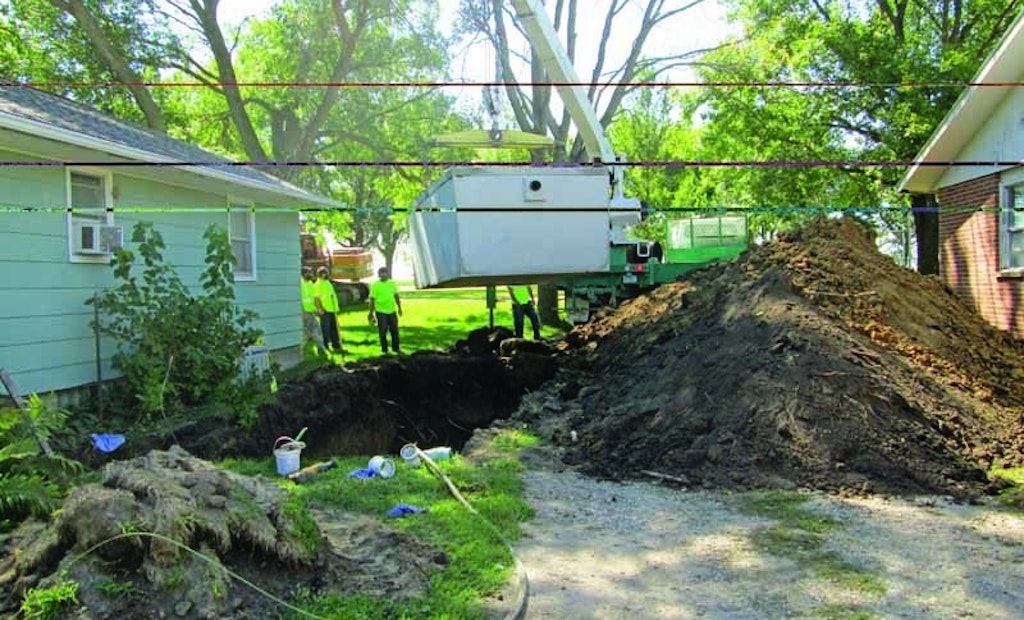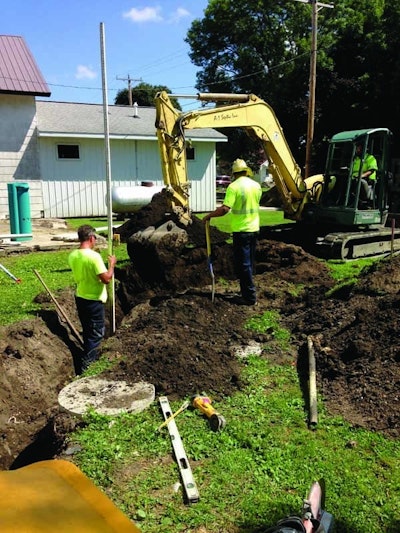
Interested in Septic Tanks?
Get Septic Tanks articles, news and videos right in your inbox! Sign up now.
Septic Tanks + Get AlertsThe State of Iowa determined it was time to modernize the wastewater system in Woden, a cluster of homes in the rural north-central part of the state. A new system serving the community brought a summer’s worth of work to North Iowa Septic Solutions (NISS) of Mason City, Iowa.
NISS worked as a subcontractor on the project. Woden consists of 137 houses and a few other buildings in an agricultural area. There’s an elevator for drying grain, a post office, a store, a bank and a restaurant. An existing wastewater system was installed primarily in the 1950s and 1960s, says Corey Nichols, project manager and co-owner of NISS.
The previous system consisted of individual septic tanks for each home, but they discharged into a ditch that ran into the channelized Lindsey Creek along the eastern side of Woden. Replacements are being ordered for direct discharge systems across the state.
The Woden project covered about 160 acres and cost an estimated $2.3 million, with $350,000 of that dedicated to the NISS portion of the work.
Modern but simple
Engineers from Jacobson-Westergard & Associates in Estherville, Iowa, designed a system to handle the community’s wastewater without the expense of a small treatment plant. Each property received a 1,600-gallon concrete septic tank from Wieser Precast Steps of Stewartville, Minnesota. These are dual-chamber tanks with half dedicated to settling and the other half housing an Orenco Systems model PF100511-30 effluent pump package with floats already in place. The tank provides settling and primary treatment.
The vault pump sends wastewater out through a 1 1/2-inch outlet pipe that NISS technicians stepped up to 4-inch HDPE ERDR11 pipe to join the sewer mains installed by another contractor. The average run was 20 feet.
Mains and lift stations move wastewater uphill to a lagoon about a half mile north of Woden, where tertiary treatment of the effluent occurs. The lagoon is divided into three cells. The largest stores 449,500 cubic feet, and each of the other two cells has a capacity of 112,600 cubic feet. The lagoons treat wastewater in stages, with the largest cell taking inflow from the mains. Eventually water is discharged into nearby Lindsey Creek. The lagoons are bordered with ballast rock on the inside and seeded on the back slope. They are not designed to be cleaned, but Nichols says he has heard of problems in other communities that choose to save money by emptying pump trucks into lagoons. In those cases the communities may have to aerate in order to promote digestion of the organics. The lagoons and mains were all in place when NISS began its work.
Commercial buildings received the same package. Those businesses have so few patrons at any given time that they do not produce a flow large enough to warrant a larger tank, Nichols says. Although no grease trap was specified for the restaurant, Nichols took the precaution of mentioning the issue. If the owner sees a problem developing, Nichols already knows where a trap can be installed.
Abandon and replace
“I have to give the engineer a lot of credit because he had the locations of the old tanks correct almost every time,” Nichols says. Only four or five were difficult to locate. “We removed the ones we needed to when they were in the way of our excavation, and when we could we abandoned the old tanks in place.” Of the 137 tanks NISS dealt with, technicians had to remove about 45.
Many of those old tanks were steel, and some fed two- or three-tile drainfields. In this part of Iowa that means one to three 24-inch tiles of about 100-gallon capacity each set in a row.
“I was only at each house for one day. People were nice enough to give me those five hours and do their best to not use water while we were working. Some people work in Mason City and weren’t home until 7 or 8 at night.” As his crews worked setting two to three tanks per day, Nichols moved a block ahead to meet as many people as he could and explain what would happen. Everyone in town had a copy of his schedule so they knew when to expect a service interruption. There was also a municipal employee acting as a liaison with the community, and this same person became responsible for managing the completed system and will arrange for tank pumping when that becomes necessary.
Doing the job took almost the entire 2015 season. Work started May 15 and ended about Sept. 15. Half of the company was devoted to the project — two two-man crews and a floater, who was Nichols. Rain delayed the project by about a month to a month and a half. Because the job was only about 45 miles from the NISS office, crews drove to the job site every day and were not stuck idle in a motel waiting for the soil to dry out.
Pumping water
Groundwater sometimes made the job less than enjoyable. The water table was naturally high in the area, and rains didn’t help. Main Street, which runs roughly through the center of Woden from north to south, was the high point, and the land sloped away to either side. Soils varied from sandy to clay.
“We had to pump out our holes most of the time with a Multiquip electric pump. Typically we did that after we set the tank and before we backfilled. Leaving water in the hole helped stabilize the sides of the excavation when we dug in sand. When we worked in clay we could pump while we were digging.”
For digging and other heavy work the crews used a Yanmar VIO75 excavator, a Case CX160 excavator, a Case 590 tractor backhoe, and a Case TR270 tracked skid-steer.
At their best pace technicians could set three tanks per day, he says. Sometimes they had to replace the pipes coming out of buildings with new Schedule 40 PVC. In a few cases they had to dig down 12 or 13 feet in order to get a gravity feed from wastewater pipes that emerged at the bottoms of basements. In these cases they made long custom riser tubes from large plastic pipes supplied by Orenco. Elsewhere, tanks were fitted with standard Orenco risers, and Orenco lids were used throughout the project.
Even though the Woden wastewater system was not that old, it needed to be upgraded. Thanks to NISS and the other contractors, the town now has a system that will treat its wastewater without endangering the environment.








